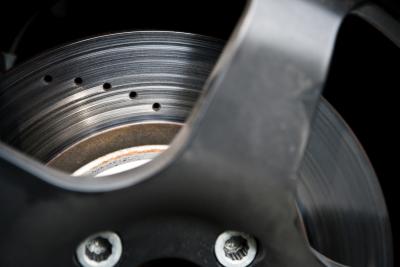
Loud noises emanating from your ride can definitely detract from the joy of motoring. Brake sounds add another dimension to this annoyance by raising safety concerns. When this disturbing occurrence coincides with recent repairs, workmanship and materials are called into question. The possibility of looming brake failure may add a sense of urgency to the situation, but some brake noises are somewhat less serious than others. A thorough and proper diagnosis can help eliminate the ruckus and alleviate anxieties. Whether the rear brakes are drum or disc styles, noisy operations should be investigated promptly.
Drum brake designs and construction are tried and true and have afforded good service for decades. Even so, certain requirements must be fulfilled for silent and sufficient function. Brake drums can be worn in a manner that results in a slight taper across the braking surface that widens toward the open side of the drum. The bell-mouthed distortion might go undetected during shoe replacement, and the new shoes do not mate with the taper. An alarming howling tone radiates from the drums and seems to permeate the entire vehicle. A taper in the opposite side of the drum can be the caused by metal fatigue or overheating. Both instances produce a similar sound.
Grooves and scores can be cut into the brake drum by shoes that are worn down too far. Once the friction material, or lining, has been worn away, metal portions of the shoe assembly can contact the drum and score the surface. Loose lining material and dust in the drum may also contribute to the scoring. Replacement shoes only contact the high parts of the grooved surface, and a squeal or groaning sound may occur. Many of these deficiencies can be corrected by restoring the machined finish on the inside of the drum on a lathe built for the purpose. Hard spots on the friction surface of the drum develop from harsh applications or overloaded vehicles. Excessive heat darkens and hardens sections of the drum, creating a chattering sound. Conventional machining methods can not correct this malady, and new drums are required.
The lining on new or rebuilt brake shoes is typically tapered at each end to prevent heel or toe contact with the drum. Bargain replacement shoes may not have this feature, and the square edge of the material impacts the drum sharply at times. The sound of this can differ between applications, but squeals and scuffing noises can occur intermittently. File a bevel into the top and bottom edges of these type shoes if better parts are not available. Brake shoes have different lengths of lining bonded or riveted in place. The shoe with the shorter lining is meant to be the leading, or front brake shoe. It is possible to mount the shoes in the wrong position, and any noises created could seem trivial in comparison to the loss of stopping power.
Every detail of proper friction surface requirements may be even more critical on rear disc brakes. Rear brake rotors, or discs, are typically solid in construction, rather than the vented rotors found on front axles. Irregularities on the solid friction surfaces are more likely to "sound off," and often do not respond to machining efforts. Shims or backing substances missing from bargain brake pads might soon reveal their necessity. Quality replacement parts replicate original equipment for this reason and are often fashioned with tapers and slots in the lining material to prevent sounds, and heat accumulation. Brake pads made of materials other than those recommended by the vehicle maker may raise an intermittent racket all their own.